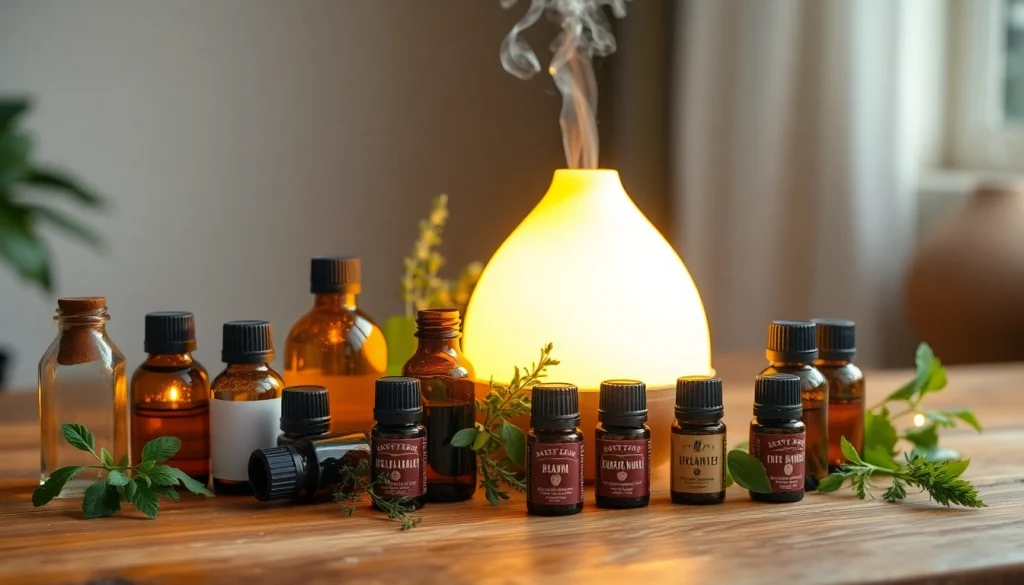
Understanding Essential Oils
What Are Essential Oils?
Essential oils are highly concentrated extracts derived from various parts of plants, including leaves, flowers, bark, stems, and roots. These oils capture the plant’s scent and flavor, commonly known as the plant’s “essence.” Unlike the fatty oils commonly used in cooking or as skin moisturizers, essential oils are volatile compounds that evaporate quickly and possess strong aromatic qualities. Their unique chemical structures allow them to interact with human physiology, thereby delivering various therapeutic benefits. The versatility of essential oils has led to their increased popularity in aromatherapy, skincare, and even culinary practices. To learn more about the various applications and how they contribute to holistic health, consider exploring resources, including essential oil information tailored for wellness enthusiasts.
The Science Behind Essential Oils
The science of essential oils blends botany and chemistry, focusing on how these aromatic compounds impact our health. Each essential oil consists of a complex mixture of numerous components, primarily terpenes and phenolics. For instance, lavender oil contains linalool—an ingredient widely recognized for its calming effects, while tea tree oil is known for its antimicrobial properties due to compounds like terpinen-4-ol. Research in both fields has uncovered the therapeutic potential of essential oils, spotlighting essential oils in studies exploring aromatherapy’s efficacy in managing stress, anxiety, and pain relief. Understanding the science behind these oils can greatly enhance their safe and effective use.
Common Types of Essential Oils
Essential oils come in various types, each with specific properties and applications. Some of the most common include:
- Lavender Oil: Renowned for its calming effects, lavender oil is often used in aromatherapy to alleviate stress and promote restful sleep.
- Peppermint Oil: Known for its invigorating aroma, peppermint oil can ease headaches and enhance mental clarity.
- Tea Tree Oil: This oil is widely recognized for its antiseptic properties, making it a popular choice for skincare treatments and household cleaners.
- Lemon Oil: With its fresh scent, lemon oil is often used to boost mood and energy levels, and it also possesses antibacterial properties.
- Frankincense Oil: Revered for its historical significance, frankincense oil is utilized in meditation practices and is thought to promote emotional balance.
Benefits of Essential Oils
Physical Health Benefits of Essential Oils
Essential oils offer numerous physical health benefits that can enhance overall well-being. Many oils possess antiseptic, anti-inflammatory, and analgesic properties, making them effective in treating various ailments. For example, eucalyptus oil is frequently used to support respiratory health, helping to clear congestion and boost immune function. Similarly, ginger oil is often employed for its digestive benefits, helping to alleviate nausea and improve gut health.
Mental and Emotional Well-being with Essential Oils
The benefits of essential oils extend beyond physical health. These potent extracts are influential in promoting mental and emotional well-being. Research indicates that certain scents can positively impact mood by stimulating parts of the brain that regulate emotions. For instance, citrus oils like orange and grapefruit can elevate mood and increase feelings of happiness. In contrast, oils such as chamomile or vetiver can promote relaxation and help reduce symptoms of anxiety, making essential oils a promising adjunct in mental health treatments.
Essential Oils in Home Care
Incorporating essential oils into home care routines enhances not only the atmosphere but also contributes to a healthier living environment. Natural disinfectant properties found in oils like tea tree and lemon are effective for cleaning surfaces and purifying the air. Additionally, oils like lavender can be used in homemade diffusers or spritzers to create a calming ambiance. By seamlessly integrating essential oils into everyday cleaning and atmosphere-setting routines, households can benefit from both the therapeutic and practical qualities of these natural solutions.
How to Choose Quality Essential Oils
Identifying Genuine Essential Oils
Choosing quality essential oils is crucial to ensure safety and efficacy. Start by familiarizing yourself with reputable brands and suppliers known for their transparency and quality control practices. Genuine essential oils should come from plants that have been harvested properly and distilled using methods that preserve their therapeutic qualities. Look for companies that provide detailed information about their sourcing, distillation processes, and any available testing results to verify purity.
Reading Labels: What to Look For
When purchasing essential oils, educated consumers know to examine labels closely. Look for the Latin name of the plant, which confirms its botanical identity, and verify that the oil is 100% pure, without synthetic additives. Additionally, check for indications of proper extraction methods—such as steam distillation or cold-pressed—since these processes maintain the oil’s natural properties. Attention to these details can significantly influence the quality of the essential oil you choose.
Essential Oil Grades Explained
Essential oils vary in quality and grade, significantly impacting their therapeutic value. Commonly, oils are categorized as therapeutic grade, food grade, or cosmetic grade. Therapeutic-grade oils are often considered the highest quality, suitable for therapeutic use. Food-grade oils are safe for culinary applications, while cosmetic grades may contain fillers or synthetic ingredients and may not be suitable for therapeutic use. Understanding these distinctions will guide you in choosing the right oil for your specific needs.
Popular Essential Oil Uses
Essential Oils for Relaxation and Stress Relief
One of the most popular uses of essential oils is for relaxation and stress relief. Oils like lavender, chamomile, and ylang-ylang have been used for centuries to promote calm and reduce anxiety levels. These oils can be utilized in various ways, such as through diffusion in a room, applying diluted oil topically, or even adding a few drops to a warm bath. Incorporating these oils into a self-care routine can create a sanctuary-like environment and foster mental tranquility.
Essential Oils in Beauty Routines
Natural beauty products are increasingly popular, and essential oils play a vital role in enhancing skincare routines. Oils such as tea tree, frankincense, and rose can effectively target specific skin concerns like acne, signs of aging, or dryness. For instance, tea tree oil’s antibacterial properties make it an excellent choice for acne-prone skin, while rose oil can hydrate and soften the skin, promoting a radiant complexion. Incorporating essential oils into DIY skincare formulations allows for personalization while harnessing the power of nature in enhancing beauty.
Using Essential Oils in Cooking
Essential oils can also be utilized in culinary applications, adding flavor and health benefits to various dishes. Oils like lemon, peppermint, and ginger can infuse recipes with vibrant tastes while offering additional nutritional support. However, it’s important to remember that essential oils are potent, so only a small amount is necessary to achieve the desired flavor. Understanding the correct use, dilution, and compatibility of essential oils in food preparation can expand your culinary repertoire while promoting your health.
Safety Precautions with Essential Oils
Common Allergies and Sensitivities
While essential oils offer myriad benefits, it’s crucial to be aware of potential allergies and sensitivities. Certain individuals may experience skin irritation or adverse reactions when using specific oils. Conduct a patch test before applying any new essential oil to the skin, and consult with a healthcare professional if you have any concerns regarding allergies or known sensitivities. Being mindful of individual reactions can help prevent unwanted side effects and ensure a positive experience with essential oils.
Proper Dilution Techniques
Most essential oils are highly concentrated and should always be diluted before topical application to minimize the risk of irritation. Common carrier oils—such as coconut oil, jojoba oil, or sweet almond oil—are typically used to dilute essential oils. A standard guideline is to use 2-3 drops of essential oil per teaspoon of carrier oil for adults. For children or individuals with sensitive skin, a lower dilution ratio is advisable. Proper dilution enhances the safety and efficacy of essential oils, allowing for enjoyable use without adverse effects.
Storing Essential Oils Safely
Safe storage of essential oils is essential to maintain their quality and effectiveness over time. Store oils in dark glass containers, as exposure to light can degrade their quality. Additionally, keep them in a cool, dry place away from direct sunlight and heat sources to ensure longevity. Properly labeled storage units can prevent misuse or accidental ingestion. By following these storage practices, you’ll preserve the therapeutic benefits of your essential oils, ensuring they remain effective whenever you reach for them.






